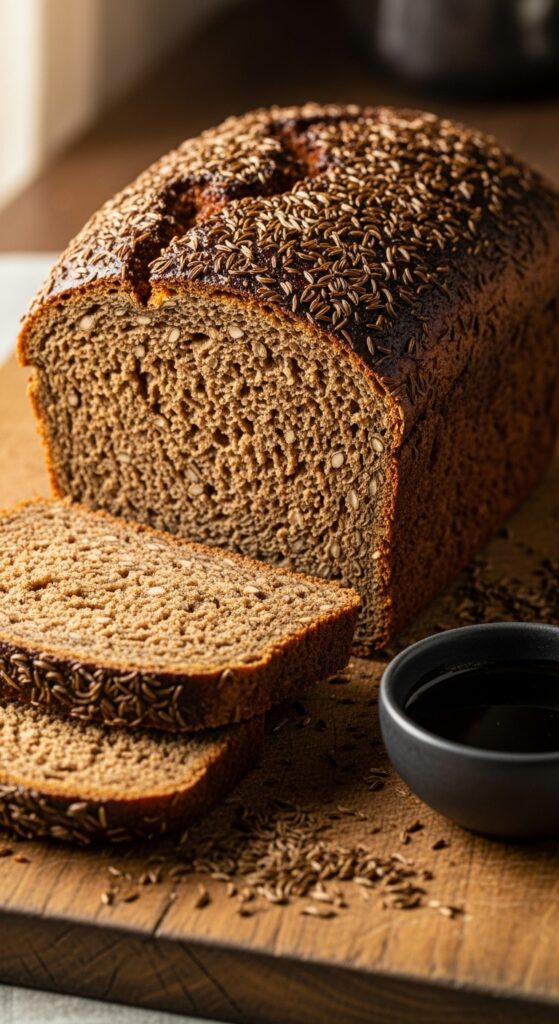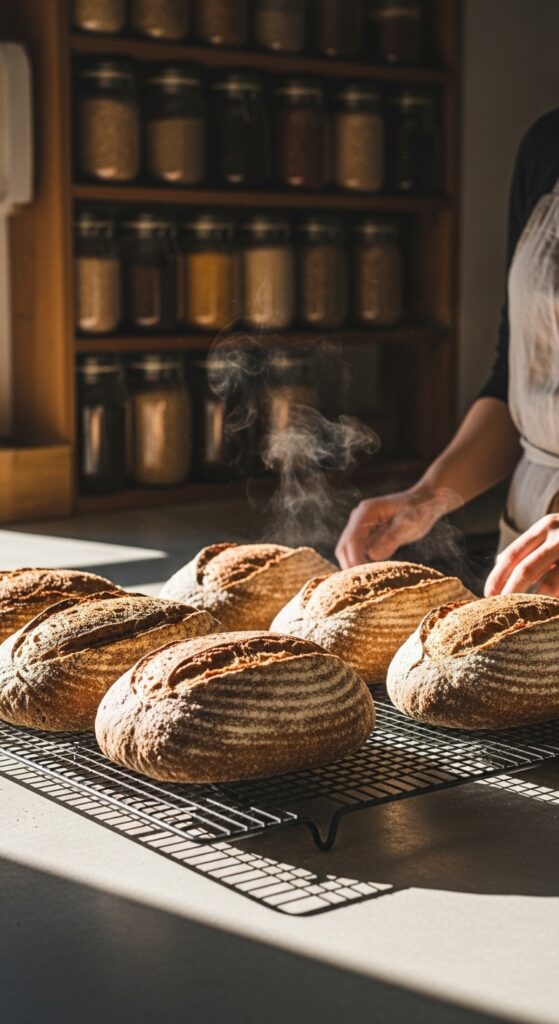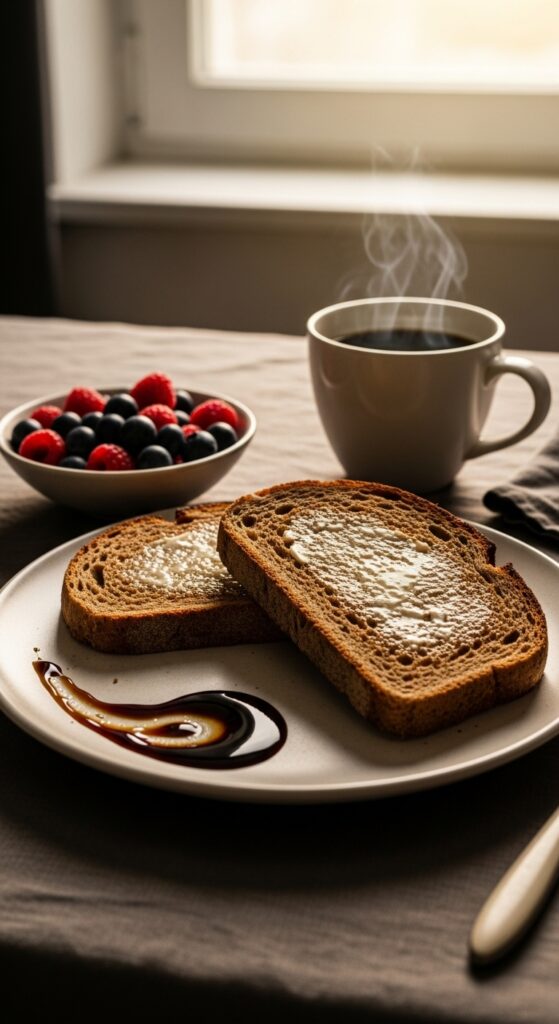There’s something grounding about baking bread. The smell of yeast blooming, the warmth of the oven, the deep, earthy aroma that fills the kitchen—it feels ancient, honest. And when that bread is classic rye with caraway and molasses, it becomes something more. Rustic. Soulful. The kind of loaf that demands butter (vegan or not), mustard, or a thick smear of jam.
If you’ve ever torn into a slice of real rye bread—dense yet tender, dark with molasses, perfumed with caraway—you know it’s not just bread. It’s character in edible form. It’s a recipe with roots in old-world Europe, loved by bakers for centuries. And when done right, it’s downright addictive.
So let’s roll up our sleeves and make this classic vegan rye bread from scratch—simple ingredients, a little patience, and a whole lot of flavor.

Why It’s Special
Rye bread has history. Long before white loaves and sourdough trends, rye was the grain of the people—especially in Eastern and Northern Europe. It thrived in cold, poor soil where wheat couldn’t grow. It was dense, dark, and hearty, keeping people full during long winters.
That resilience gave rye bread its reputation: humble but strong, deeply flavorful, with a tang and chew that lasts. Add caraway seeds, and you get that unmistakable aroma—warm, slightly peppery, almost citrusy. Molasses adds sweetness and depth, creating the bread’s signature color and rich undertone.
This version is 100% vegan, but you’d never guess it. No eggs, no dairy—just good flour, water, yeast, and time. The combination of rye and wheat makes it easier to handle than pure rye dough (which can be sticky and dense). The result is a loaf with old-world flavor and modern-day lightness.
It’s the kind of bread that sits proudly on your counter, begging to be sliced thick and slathered with something delicious.

Ingredients & Substitutions


This bread relies on a few simple but purposeful ingredients. Each one brings something unique to the table.
Core Ingredients
- Rye flour (2 cups): The heart of the loaf. Choose medium or dark rye for rich flavor. Light rye gives a milder taste and lighter color.
- Bread flour (1 ½ cups): Adds gluten structure and helps the loaf rise properly. You can use all-purpose if that’s what you’ve got.
- Instant yeast (2 ¼ tsp): Reliable, fast, and easy. If using active dry yeast, proof it in warm water first.
- Warm water (1 ¼ cups): Activates the yeast. Aim for 105–110°F—not too hot or you’ll kill it.
- Molasses (2 tbsp): Adds sweetness, color, and that deep, earthy note. Unsulfured molasses is best for a clean flavor.
- Caraway seeds (1–1 ½ tbsp): The soul of rye bread. You can toast them lightly for a nuttier aroma.
- Salt (1 ½ tsp): Balances sweetness and strengthens the gluten network.
- Olive oil or vegan butter (2 tbsp): For moisture and tenderness.
Optional Ingredients
- Brown sugar (1 tbsp): Adds subtle sweetness and helps browning.
- Apple cider vinegar (1 tsp): Gives a light tang and enhances rise.
- Vital wheat gluten (1 tbsp): Boosts elasticity if your rye flour is very dense.
- Seeds for topping: Sunflower, poppy, or extra caraway seeds for crunch and style.
Substitutions
- No molasses? Use dark maple syrup or barley malt syrup. It’ll taste slightly different, but still delicious.
- Can’t find rye flour? Try whole wheat flour for a similar texture, though the flavor will be milder.
- Gluten-free? Substitute with a mix of gluten-free all-purpose and teff flour, but expect a denser crumb.
Expert Tip: Rye flour absorbs water slowly. The dough may feel sticky at first but will firm up as it rests. Resist the urge to add too much flour too soon—it needs that moisture for texture.
Step-by-Step Instructions
Baking rye bread is less about perfection and more about rhythm. It’s slower, calmer, more patient than quick breads. The dough feels different—heavier, earthier. That’s normal.
- Bloom the yeast. In a small bowl, whisk warm water with molasses until dissolved. Sprinkle in the yeast and let it sit for 5–10 minutes until foamy. This step ensures the yeast is alive and active.
- Mix the dry ingredients. In a large bowl, combine rye flour, bread flour, salt, and caraway seeds. Stir well so the seeds are evenly distributed.
- Combine wet and dry. Pour the yeast mixture and oil into the dry ingredients. Mix with a spoon or dough whisk until it forms a shaggy, sticky dough.
- Knead gently. Turn the dough onto a lightly floured surface. Knead for about 8–10 minutes. It won’t be as elastic as wheat dough—rye behaves differently. Focus on folding rather than pulling. If it sticks, dust with a little flour, but don’t overdo it.
- First rise. Transfer the dough to a greased bowl, cover with a damp towel, and let it rise in a warm spot for about 1 ½ to 2 hours, or until slightly puffed. It won’t double like white bread, but it should expand noticeably.
- Shape the loaf. Punch the dough down gently, then shape it into a round or oval loaf. Place it on a parchment-lined baking sheet or into a greased loaf pan.
- Second rise. Cover again and let it rest for another 45–60 minutes. It should feel airy and soft when poked.
- Preheat your oven. While the dough rises, heat the oven to 400°F (200°C). Place a small pan of water on the bottom rack to create steam—this helps form a crisp crust.
- Score and bake. Use a sharp knife or lame to slash the top (a few shallow cuts will do). Bake for 30–40 minutes until the crust is deep brown and the loaf sounds hollow when tapped underneath.
- Cool completely. This is important! Rye bread continues to set as it cools. Slice too soon and you’ll get a gummy texture. Wait at least an hour—two if you can resist.
Common Mistakes to Avoid:
- Overkneading. Rye dough gets sticky, not elastic. Don’t expect a smooth, stretchy dough like wheat.
- Underbaking. The dense crumb needs time. Check for that hollow sound—it’s your cue.
- Cutting early. Patience really pays off here. Let the steam finish its work.
Variations:
- Seeded Rye: Add sunflower, flax, or pumpkin seeds for texture.
- Spicy Touch: Mix in a pinch of ground fennel or anise with the caraway.
- Rye Rolls: Shape into small rounds and bake for 20–25 minutes. Perfect for sandwiches.
Cooking Techniques & Science

Rye is a different beast from wheat. It doesn’t develop gluten the same way, so structure comes more from starches than proteins. That’s why rye dough feels stickier and heavier—it’s not a failure, it’s chemistry.
The caraway seeds do more than add flavor. Their oils interact with the rye’s natural enzymes, helping preserve the bread and keeping it fresh longer. Historically, that mattered. Rye breads could last weeks without going stale.
Molasses plays three roles: it feeds the yeast, gives the bread color, and locks in moisture. The sugar caramelizes during baking, creating that signature deep brown crust.
The use of steam is another key trick. Steam delays crust formation so the loaf can expand fully before hardening. It also gives that glossy, crackly finish that makes the bread irresistible.
Tools That Help:
- A stand mixer with a dough hook if you prefer hands-free kneading.
- A bread lame or sharp knife for scoring.
- A baking stone for extra crusty results (preheat it first).
- A kitchen thermometer—internal temperature should reach 200°F when done.
Once you understand the “why,” the “how” feels effortless. You’re not just following steps—you’re reading the dough, feeling its mood. That’s when bread baking becomes art.
👉 Recipe Card
Classic Vegan Rye Bread with Caraway Seeds and Molasses
Prep time: 20 minutes (plus 2–3 hours rising)
Cook time: 40 minutes
Total time: About 3½ to 4 hours
Servings: 1 large loaf (10–12 slices)
Calories: ~160 per slice
Ingredients
2 cups rye flour
1½ cups bread flour (or all-purpose)
2¼ tsp instant yeast
1¼ cups warm water (105–110°F)
2 tbsp molasses
1½ tsp salt
1–1½ tbsp caraway seeds
2 tbsp olive oil or vegan butter
1 tbsp brown sugar (optional)
1 tsp apple cider vinegar (optional)
Instructions
- Whisk warm water and molasses in a bowl. Sprinkle in yeast and let bloom for 5–10 minutes.
- In a large mixing bowl, combine rye flour, bread flour, salt, and caraway seeds.
- Add the yeast mixture and oil. Stir until a sticky dough forms.
- Knead lightly for 8–10 minutes, adding flour as needed.
- Place in an oiled bowl, cover, and let rise for 1½–2 hours.
- Shape into a round or oval loaf. Set on parchment or in a loaf pan.
- Cover and let rise another 45–60 minutes.
- Preheat oven to 400°F with a pan of water inside.
- Slash the top and bake 35–40 minutes, until crusty and deep brown.
- Cool on a rack for at least 1 hour before slicing.
Serving & Pairing Suggestions

This rye loaf is versatile. It’s fantastic plain, still slightly warm, with a smear of vegan butter and a sprinkle of salt. The contrast between the earthy rye and sweet molasses is pure comfort.
For breakfast, pair it with avocado, sliced tomato, or almond butter and banana for a sweet-savory combo. For lunch, make a proper deli-style sandwich—stacked with sauerkraut, mustard, vegan pastrami, or roasted veggies.
It also loves soups. A thick slice dipped into lentil stew or split pea soup is classic and cozy. For drinks, go for something bold—black coffee, strong tea, or even a dark beer. Rye loves intensity.
And if you’re entertaining, toast it thin and top with hummus, pickles, or roasted peppers. It holds up beautifully.
Conclusion
Making Classic Vegan Rye Bread with Caraway Seeds and Molasses isn’t just about baking—it’s about slowing down and connecting with something timeless. This is bread with backbone. Hearty, fragrant, slightly sweet, and deeply satisfying.
It’s not the kind of loaf that disappears in one bite—it lingers. The aroma fills your kitchen, the crust sings when it cools, and every slice tells a story of patience and care.
So the next time you crave something real—something that feels homemade down to its core—grab your flour, your molasses, your caraway, and bake this loaf. You’ll taste why rye has stood the test of centuries.
And once you’ve mastered it, the possibilities open up. Add seeds, swap syrups, try different flours. Bread is alive, and so is your creativity.
FAQs
1. Why is my rye bread dense?
That’s natural to a degree. Rye has less gluten, so the crumb is tighter. But make sure your yeast is fresh and you give it enough rising time.
2. Can I make this bread without caraway seeds?
Absolutely. The flavor will be milder, more neutral. You can replace them with fennel, cumin, or leave them out altogether.
3. How do I store rye bread?
Wrap it in a clean cloth or paper bag and store at room temperature for 3–4 days. It actually improves in flavor after a day. For longer storage, freeze slices and toast as needed.
4. Can I use a bread machine?
Yes! Just add wet ingredients first, then dry, and use the “Whole Grain” or “Basic” setting. The texture may be a bit lighter, but still tasty.
5. Why does rye bread taste slightly sour?
That’s part of its charm. Rye naturally ferments faster than wheat and has mild acidity. The molasses also enhances that tang.
There you have it—the Classic Vegan Rye Bread with Caraway Seeds and Molasses, a loaf that feels like a warm hug from a bygone era. Dense yet soft, earthy yet sweet, humble yet full of personality. Bake it once, and your kitchen will smell like history meeting heart.

Selena is an experienced lifestyle blogger and the voice behind many of Cozy Toned’s inspiring posts. With a passion for mindful living, home styling, and everyday wellness, she shares practical tips and fresh ideas to help readers live beautifully and intentionally.